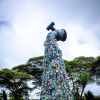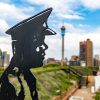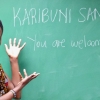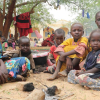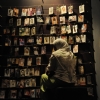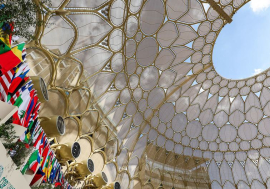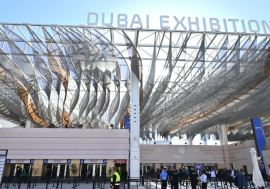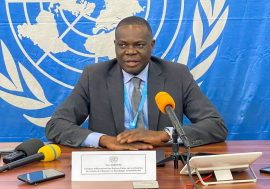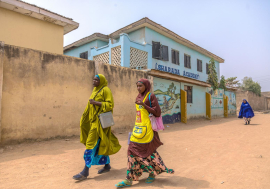Cameroon celebrates its 50th anniversary
Cameroon celebrates its 50th anniversary
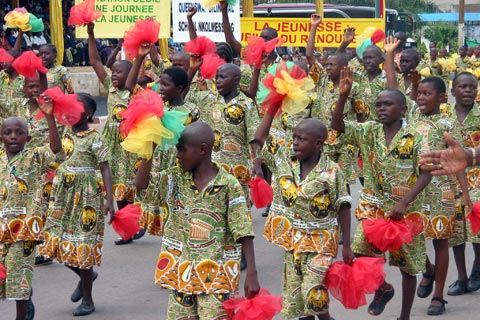 School children march in celebrations marking Cameroon’s 50th anniversary of independence.
School children march in celebrations marking Cameroon’s 50th anniversary of independence.Yaoundé — The central streets and roundabouts of Cameroon’s hilly capital were adorned with banners, flowers and coloured light displays as thousands of soldiers and other citizens marched in a festive parade on 20 May to mark a half century since the country first gained its national sovereignty. “Cameroon is free and independent,” declared a large parade sign. “Unity and solidarity,” “long live national integration,” “development of Cameroonian women” and many other slogans featured on the placards of succeeding contingents.
Among people in Yaoundé’s poorer outlying districts, there also was some expression of pride, especially during local parades that wound down their dusty streets in the days leading up to the national commemoration. But with jobs limited and the prices of basic foodstuffs and other necessities painfully high, many were more preoccupied with the struggle to simply get by. And as President Paul Biya reminded Cameroonians in a national address kicking off the 50th anniversary events, “it must be admitted that the most vulnerable part of our population, especially in the rural areas, has not seen its conditions improve significantly” since independence.
Cameroon was not alone in achieving its freedom 50 years ago, in 1960. Sixteen other African countries — mostly former French colonies but also Nigeria, Somalia and the Democratic Republic of the Congo (DRC) — also attained their sovereignty that year. A number of their leaders joined the dignitaries on the reviewing platform at the 20 May parade or attended the opening of a two-day international conference that preceded the event. They included the presidents of Algeria, Burkina Faso, Central African Republic, Chad, Congo Republic, Côte d’Ivoire, DRC, Equatorial Guinea, Gabon, and São Tomé and Príncipe. Cameroon’s powerful neighbour to the north, Nigeria, was represented not only by recently inaugurated President Goodluck Jonathan, but also by former presidents Olusegun Obasanjo and Yakubu Gowon.
Regional peace, domestic strains
Nigeria’s high-profile presence in Yaoundé was a tribute to how much relations between the two countries have improved. In 1981 Nigeria and Cameroon nearly went to war over the disputed Bakasi Peninsula, followed by more armed clashes in the 1990s and Nigerian military occupation. Although the International Court of Justice ruled in 2002 that Bakasi belonged to Cameroon, it took several more years and concerted UN mediation before Nigeria agreed to implement the ruling and finally withdrew in 2008. The peaceful resolution of that border conflict was especially notable for a region of Africa that has seen so many wars and insurgencies.
Unlike many of its neighbours, Cameroon itself has remained at relative peace — that is, after the bloody years that marked its birth as an independent state. Before France finally agreed to end its administrative rule, radical pro-independence insurgents led by Ruben Um Nyobé fought a tenacious struggle for sovereignty in the late 1950s, but were militarily defeated. President Ahmadou Ahidjo, who came to power with French backing, continued counter-insurgency operations against the remnants of the rebellion into the early 1970s. That experience reinforced the authoritarian tendencies of the government, which also centralized the Cameroonian state in 1972 by abolishing a federal system that was established in 1961 when an Anglophone territory previously administered by the UK voted to join Cameroon.
That history has left a lasting and controversial legacy. During the 20 May parade, members of a political party claiming allegiance to the early pro-independence insurgents were barred from carrying portraits of Um Nyobé and other rebel leaders. Activists of another party, the largest opposition group in parliament, unfurled signs calling for a return to federalism and denouncing the electoral commission as biased in favour of President Biya’s party.
A number of Cameroonians — opposition supporters, independent journalists, academics and even some members of the ruling party — openly express disillusionment with the country’s seeming political stagnation, despite the return to multiparty politics in the early 1990s. President Biya has been in office for 28 years, ever since Mr. Ahidjo stepped down after an illness in 1982. The constitution was amended in 2008 to permit the 77-year-old incumbent to run for re-election yet again in 2011.
Economic ups and downs
Government supporters argue that such prolonged political stability has been an important factor in the country’s economic and social achievements. With a population of 20 million, Cameroon is rich in timberland and waterways, exploits notable oil deposits and other mineral resources and has a diversified manufacturing sector. Its per capita gross domestic product is among the top 10 in sub-Saharan Africa.
But like many of its neighbours, Cameroon remains vulnerable to external economic shocks. As President Biya has noted, these include deteriorating terms of trade, a slowdown in growth in Europe and Asia (to which Cameroon sells many of its exports) and erratic price fluctuations for oil and other raw materials. “All these phenomena have had negative consequences for our economy,” he said.
In recent years, Cameroon’s economic growth rates have generally been below the sub-Saharan average. Nearly 58 per cent of its people earn less than US$2 a day, and a third under US$1.25 a day. In 2008, sharply higher food and fuel prices prompted serious rioting in Yaoundé, Douala and more than two dozen other towns.
According to numerous analysts, such problems are worsened by Cameroon’s high levels of income inequality and its pervasive corruption. Although scores of government officials, including several ministers, have been arrested on charges of embezzlement and fraud under an anti-corruption crackdown known as Operation Sparrowhawk, Cameroon continues to be ranked by Transparency International and other groups among the more corrupt countries in Africa.
On the positive side, Cameroon has invested heavily in education. After some deterioration in the 1990s resulting from budgetary constraints, government spending began to increase in 2000, leading to the construction of thousands of new classrooms, higher salaries for teachers and the abolition of fees for primary school students. The country’s enrolment ratios are comparable to the average for sub-Saharan Africa, and its literacy rate is slightly above the average. Cameroon now has 190,000 students in its seven universities, compared with just 1,000 university students in 1961.
In the hopes that these young Cameroonians will eventually be able to find jobs, the government has recently launched a 10-year “growth and employment” strategy. It aims to increase investments in roads, power networks and other infrastructure, modernize aging industries and strengthen health, education and professional training.
— Africa Renewal online


